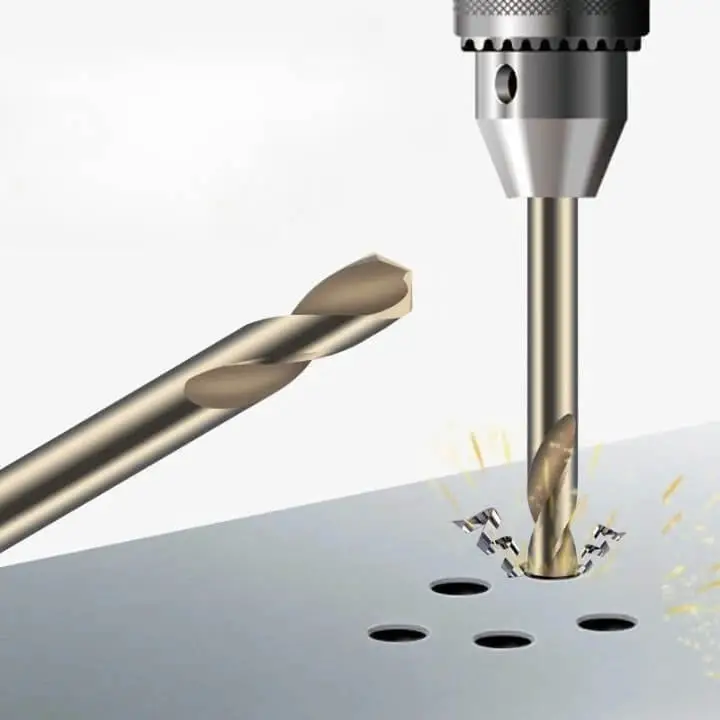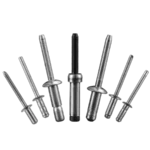Pop Rivet Drill Bit Size Chart
The POP Rivet Drill Bit Size Chart is a reference tool used to match rivet diameters to drill sizes to ensure that the punched hole size is an exact match for the blind rivet being used. The table typically lists common rivet sizes (e.g., 1/8“, 3/16”, 1/4″) and their corresponding recommended drill sizes (e.g., #30, #11, F size, etc.). Using the correct drill size ensures that rivets are installed securely and clamped reliably, and avoids rivet failure, pullout or distortion due to oversized or undersized holes. These cross-reference tables are critical assembly tools in metal fabrication, automotive, aerospace and equipment assembly.
| Rivet Diameter (inch) | Rivet Diameter (mm) | Recommended Drill Bit (US #) | Drill Bit Size (inch) | Hole Diameter (mm) |
|---|---|---|---|---|
| 3/32″ | 2.4 mm | #41 | 0.096″ | 2.44 mm |
| 1/8″ | 3.2 mm | #30 | 0.1285″ | 3.26 mm |
| 5/32″ | 4.0 mm | #20 | 0.161″ | 4.09 mm |
| 3/16″ | 4.8 mm | #11 | 0.191″ | 4.85 mm |
| 7/32″ | 5.6 mm | #1 | 0.228″ | 5.79 mm |
| 1/4″ | 6.4 mm | F | 0.257″ | 6.53 mm |
| 9/32″ | 7.1 mm | I | 0.272″ | 6.91 mm |
| 5/16″ | 7.9 mm | O | 0.316″ | 8.03 mm |
| 3/8″ | 9.5 mm | 3/8″ Drill | 0.375″ | 9.52 mm |
Instructions for use:
- The recommended drill diameter is slightly larger than the rivet body to allow insertion but not excessive looseness to avoid de-riveting or insufficient clamping force.
- Drill numbering is mainly in the American system (# number), commonly used in aerospace and industrial assembly; F, I, O, etc. are alphabetical system drills.
- If stainless steel or structural blind rivets are used, it is recommended that a 0.1-0.2 mm cushion be added to the hole diameter.
I'm using 1/8 inch rivets, what size drill should I go with?
If you are using 1/8-inch (3.2 mm) blind rivets (POP Rivet), the recommended drill sizes are listed below:
- U.S. Drill Bit Number: #30
- Drill Diameter (inch): 0.1285 inch
- Drill diameter (mm): approx. 3.26 mm
Technical Notes:
This size ensures that the rivet can be inserted smoothly into the hole and creates sufficient expansion force during clamping to ensure reliable fixing. If the hole size is small, it may cause the rivet to be difficult to insert or the installation may be deformed; if the hole size is large, it may cause loosening, insufficient clamping force or risk of pulling off.
If you are using stainless steel blind rivets, structural rivets, or for high vibration/high load environments, consider slightly increasing the drill diameter (+0.05mm) to facilitate installation and control stress concentrations.

how do i match rivet size to hole size?
Matching rivet size to hole diameter is critical to ensuring the strength, safety and stability of the riveted joint. Improper matching can lead to failure to install the rivet, loose connections, structural fatigue and even dislodgement.
Rivet Body vs. Hole Diameter Matching Guidelines
| Item | Recommended Value | Notes |
|---|---|---|
| Hole Diameter (Dₕ) | Rivet body diameter + 0.1–0.2 mm | Allows proper insertion and forming without excessive looseness |
| Rivet Body Diameter | Nominal size (e.g., 3.2 mm / 1/8″) | Refers to the shaft diameter, excluding the head |
| Tolerance Control | Typically ±0.05 mm | Depends on manufacturing and assembly precision |
| For High-Vibration or Structural Use | Use tighter hole-to-body clearance | Enhances shear strength and reduces post-installation play |
If the rivet diameter is 3.2mm (1/8″), the recommended hole diameter is 3.26-3.30mm with a tolerance range of +0.06 to +0.10mm.
If the hole diameter is too small, it will lead to installation difficulties, rivet deformation, equipment damage; if the hole diameter is too large, it will lead to reduced clamping force, structural loosening, vibration or pull-off.
If your project requires the use of automated assembly, it is recommended to control the hole diameter tolerance more strictly to improve consistency. If the material to be riveted is soft (e.g. aluminum), excessive clearance should be avoided to prevent the material from “pulling out” or tearing.
what happens if the hole is too big for the pop rivet?
If the hole diameter is too large, i.e. outside the recommended matching range of rivet body diameters (typically +0.1-0.2 mm), a number of negative effects on riveting quality and structural reliability can result.
Effects of Oversized Rivet Holes
| Issue | Description |
|---|---|
| Insufficient Clamping Force | Rivet cannot fully compress the materials, leading to loose joints |
| Increased Pull-Out Risk | Rivet head may slip through the hole under load or vibration |
| Reduced Shear Strength | Excess clearance causes side-to-side movement, weakening structural load |
| Noise and Vibration | Loose fit can lead to rattling in dynamic environments |
| Poor Sealing Performance | Compromised air/water tightness in enclosures or HVAC systems |
| Misalignment or Visual Defects | Off-center installation or deformed heads affect assembly quality |
| Rivet Failure During Setting | Improper hole size disrupts blind rivet formation; mandrel may break prematurely |
Response Suggestion:
- Re-drill holes and replace with a larger rivet size (e.g. 3.2 mm → 4.0 mm) to ensure hole wall fit.
- Use structural blind rivets (with locking core design) to improve clamping and shear resistance.
- Add washers or backing plates to extend the bearing surface, especially on soft base materials.
- Consider using an expanding rivet nut or filler gel to aid in fixing where the hole size cannot be changed.
can i use metric drill bits for imperial rivets?
The use of metric drills to install inch rivets is not normally recommended. Fractional rivets (e.g. 1/8“, 3/16”, etc.) are designed with hole diameters based on inch standards, and metric drill bits (e.g. 3.0mm, 4.5mm, etc.) do not usually have diameters that precisely match fractional hole diameters.
how much clearance should be allowed for pop rivet holes?
Rivet hole diameters should normally be 0.10 to 0.20 mm larger than the body diameter of the rivet, depending on the diameter of the rivet and the application environment.
- For small rivets up to 4 mm in diameter, a 0.10 mm larger hole is recommended;
- For medium-sized rivets from 4 to 6.4 mm, 0.15 mm larger is recommended;
- For large rivets over 6.4 mm, a hole size of approximately 0.20 mm is recommended.
This clearance ensures that the rivet is inserted smoothly, but not loosely, which is good for the quality of the molding and the stability of the clamping force. In practice, be sure to use a micrometer or drill gauge to confirm that the drill bit matches the rivet to avoid human error.
do blind rivets and solid rivets require different hole sizes?
Blind rivets and solid rivets drilling size is generally not exactly the same, because their structure and molding methods are different, the hole size requirements are also slightly different. Blind rivets allow for slightly larger holes for easier insertion and riveting. Solid rivets require a tighter hole fit to ensure structural strength. Blind rivets can be tolerated if there is a large drilling error, but solid rivets may not be riveted correctly. If you are handling both types of rivets in one station, it is recommended to mark the drills separately to avoid scrap due to misuse.
is there a downloadable pop rivet drill bit size chart pDF?
We do not provide pop rivet dirll bit size chart for direct download.But you can view full pop rivet drill bit size chart online on our website.
More Chart:


